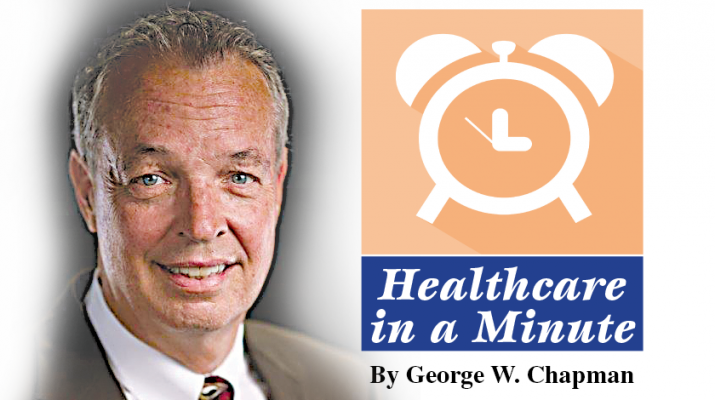By George W. Chapman
Several surveys have revealed what consumers are expecting from their healthcare providers. In no particular order, the most common expectations are: online appointments; virtual appointments; streamlined paperwork; minimal waiting; answers within 24 hours; updated waiting rooms with amenities like Wi-Fi, water, coffee; transparent pricing; and extended hours. Interestingly, one of the biggest pet peeves of those surveyed was the excessive amount of “threatening” notices plastered all over the waiting area and reception. Retail providers have been quicker to deploy these expectations and have made inroads on the market share of traditional private providers.
AMA’s Position on Healthcare
So where does the American Medical Association stand when it comes to healthcare reform? The AMA is now basically opposed to “Medicare for all,” but it recently decided to drop out of the industry group “Partnership for America’s Healthcare Future” (PAHF) which is vehemently opposed to “Medicare for all.” Rather than start from scratch, the AMA’s position is to strengthen and build upon the existing Affordable Care Act, which it believes can be a vehicle for universal coverage. The PAHF members include hospital, insurance and manufacturing trade associations. The Affordable Care Act was developed with the input of all the major stakeholders (physicians, hospitals, insurers, manufacturers) to provide and fund care for the medically uninsured and under insured. At its peak, it covered over 20 million people.
Out-of-Pocket Costs Increase Dramatically
Over the last 10 years, out of pocket costs for employer-sponsored insurance have risen twice as fast as wages and three times as fast as inflation. Last year, an average family of four spent $4,700 on premiums ($392/mo.) and about $3,000 on deductibles and copays ($250/mo.) That’s $7,700 a year or $642 a month which is a 67% increase from 2009. Wages increased 31% and inflation was 21% over the same 10 years.
What We Lie About
Medical Economics magazine surveyed hundreds of consumers to find out how forthcoming they were with their physician. It turns out about 25% actually admitted they are not. Forty-six percent of them have lied about smoking; 43% about exercise; 37% about alcohol consumption; and 29% have lied about their sexual partners. Why would people lie if they are seeking help? Seventy-five percent of the respondents who lied admitted they were embarrassed. Thirty-one percent lied to avoid discrimination and 22% lied believing their physician wouldn’t take them seriously if they were truthful. While lying only hurts the patient, it will eventually hurt their physician’s pocketbook when insurers begin to base their payments to providers on their patient outcomes. So, being 100% frank with your provider is critical to a successful partnership.
Physician Burnout
Considering the rapid-fire industry changes and continued confusion in Washington, it is no surprise that many physicians suffer from some form of burnout. Medical Economics magazine surveyed over 1,200 physicians: 92% admitted to feeling burned out at some point in their career while 68% answered they were currently feeling burned out. The most common reasons for burnout are: excessive paperwork, poor life balance; time consuming electronic medical records; and loss of control. Seventy-three percent of respondents said they have seriously considered quitting; 80% admitted they have not sought counseling. Coping mechanisms include family, exercising and hobbies. Physicians say they are increasingly powerless as medicine becomes corporatized and dictated by government and profit-oriented special interest groups.
Dealing with Death
Palliative care physician B.J. Miller advocates making end of life care more “human” and less “medicalized.” His 2015 TED talk, “What Really Matters at the End of Life,” has been viewed over 9 million times. He recently co-authored the book “A Beginners Guide to the End: Practical Advice for Living Life and Facing Death.” The book is targeted at the dying, their family and caregivers and their providers. Miller argues hospitals are a terrible place to die. Dying is not an emergency and there’s not much that can be done anymore; so, it is unfair to expect much from a hospital that is designed and staffed for acute care. But sometimes people do die there. He thinks hospitals and physicians need to be better at transitioning patients from acute to comfort or palliative care. Patients and family often feel their physician or hospital abandoned them at the end. The book is highly recommended as most of us are ill-prepared for the end.
Home Care Worker Shortage Worsening
Anyone who has had to deal with homecare for themselves or a family member is well aware of the acute shortage of home care workers. The shortage is fueled by a rapidly aging population and advanced technology which makes home care a more viable and preferable option versus nursing homes. By 2050, 19 million of us will be over 85. The president of the National Association for Home Care & Hospice says some agencies are seeing 100% turnover in a year and 50% is now considered “good.” The good news-bad news is there will be 1.2 million new jobs available by 2026 which is a 40% increase from the number of jobs in 2016. Home care is often a thankless job and it doesn’t pay well. Eighty-seven percent of home care workers are women; 60% are of color; 52% have a high school diploma or less; half receive public assistance like Medicaid or food stamps.
George W. Chapman is a healthcare business consultant who works exclusively with physicians, hospitals and healthcare organizations. He operates GW Chapman Consulting based in Syracuse. Email him at gwc@gwchapmanconsulting.com.

